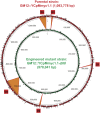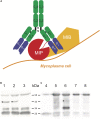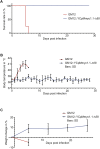Removal of a Subset of Non-essential Genes Fully Attenuates a Highly Virulent Mycoplasma Strain
- PMID: 31001234
- PMCID: PMC6456743
- DOI: 10.3389/fmicb.2019.00664
Removal of a Subset of Non-essential Genes Fully Attenuates a Highly Virulent Mycoplasma Strain
Abstract
Mycoplasmas are the smallest free-living organisms and cause a number of economically important diseases affecting humans, animals, insects, and plants. Here, we demonstrate that highly virulent Mycoplasma mycoides subspecies capri (Mmc) can be fully attenuated via targeted deletion of non-essential genes encoding, among others, potential virulence traits. Five genomic regions, representing approximately 10% of the original Mmc genome, were successively deleted using Saccharomyces cerevisiae as an engineering platform. Specifically, a total of 68 genes out of the 432 genes verified to be individually non-essential in the JCVI-Syn3.0 minimal cell, were excised from the genome. In vitro characterization showed that this mutant was similar to its parental strain in terms of its doubling time, even though 10% of the genome content were removed. A novel in vivo challenge model in goats revealed that the wild-type parental strain caused marked necrotizing inflammation at the site of inoculation, septicemia and all animals reached endpoint criteria within 6 days after experimental infection. This is in contrast to the mutant strain, which caused no clinical signs nor pathomorphological lesions. These results highlight, for the first time, the rational design, construction and complete attenuation of a Mycoplasma strain via synthetic genomics tools. Trait addition using the yeast-based genome engineering platform and subsequent in vitro or in vivo trials employing the Mycoplasma chassis will allow us to dissect the role of individual candidate Mycoplasma virulence factors and lead the way for the development of an attenuated designer vaccine.
Keywords: Mycoplasma mycoides subsp. capri; attenuation; genome engineering; in vivo challenge; virulence traits.
Figures





Similar articles
-
Attenuation of a Pathogenic Mycoplasma Strain by Modification of the obg Gene by Using Synthetic Biology Approaches.mSphere. 2019 May 22;4(3):e00030-19. doi: 10.1128/mSphere.00030-19. mSphere. 2019. PMID: 31118296 Free PMC article.
-
First Report and Comparative Genomic Analysis of a Mycoplasma mycoides Subspecies capri HN-A in Hainan Island.Microorganisms. 2022 Sep 26;10(10):1908. doi: 10.3390/microorganisms10101908. Microorganisms. 2022. PMID: 36296185 Free PMC article.
-
In vivo role of capsular polysaccharide in Mycoplasma mycoides.J Infect Dis. 2019 Apr 19;219(10):1559-1563. doi: 10.1093/infdis/jiy713. J Infect Dis. 2019. PMID: 30541131 Free PMC article.
-
Pathogenicity of the subspecies mycoides of Mycoplasma mycoides for cattle, sheep and goats.Zentralbl Bakteriol Orig A. 1979 Oct;245(1-2):164-70. Zentralbl Bakteriol Orig A. 1979. PMID: 44610 Review.
-
Taxonomy of the Mycoplasma mycoides cluster.Isr J Med Sci. 1987 Jun;23(6):632-5. Isr J Med Sci. 1987. PMID: 3312102 Review.
Cited by
-
A genetic toolkit and gene switches to limit Mycoplasma growth for biosafety applications.Nat Commun. 2022 Apr 7;13(1):1910. doi: 10.1038/s41467-022-29574-0. Nat Commun. 2022. PMID: 35393441 Free PMC article.
-
Attenuation of a Pathogenic Mycoplasma Strain by Modification of the obg Gene by Using Synthetic Biology Approaches.mSphere. 2019 May 22;4(3):e00030-19. doi: 10.1128/mSphere.00030-19. mSphere. 2019. PMID: 31118296 Free PMC article.
-
Advances in Enhanced Menaquinone-7 Production From Bacillus subtilis.Front Bioeng Biotechnol. 2021 Jul 19;9:695526. doi: 10.3389/fbioe.2021.695526. eCollection 2021. Front Bioeng Biotechnol. 2021. PMID: 34354987 Free PMC article. Review.
-
Host-Pathogen Interactions of Mycoplasma mycoides in Caprine and Bovine Precision-Cut Lung Slices (PCLS) Models.Pathogens. 2019 Jun 20;8(2):82. doi: 10.3390/pathogens8020082. Pathogens. 2019. PMID: 31226867 Free PMC article.
-
Contagious Bovine and Caprine Pleuropneumonia: a research community's recommendations for the development of better vaccines.NPJ Vaccines. 2020 Jul 24;5(1):66. doi: 10.1038/s41541-020-00214-2. eCollection 2020. NPJ Vaccines. 2020. PMID: 32728480 Free PMC article. Review.
References
Grants and funding
LinkOut - more resources
Full Text Sources
Other Literature Sources
Molecular Biology Databases

